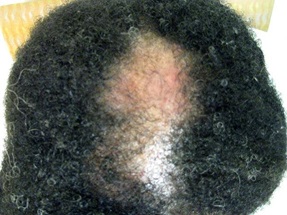
What is cicatricial alopecia?
Cicatricial alopecia is a disease characterised by central hair loss with scarring. It is fairly uncommon and mostly affects African adult women with curled hair. In 1968, it was called “hot comb alopecia” based on a theory that their hair loss was due to thermal damage from the use of a very hot comb to straighten their curly hair. In 2001, it was renamed as “central centrifugal cicatricial alopecia” (CCCA). Besides hair loss, cicatricial alopecia signs include inflammation (redness, scales and pustules) and symptoms of scalp pain, tenderness and itching. The disease begins with subtle hair thinning on the middle of the top scalp. One of the early signs may be unexplained hair breakage. Over time, hair loss worsens and the involved zone increases in an outward manner. The most central zone is the most severely affected part with total balding. Discolouration of the scalp is often seen in severe cases. Tufted hair may also be present. Symptoms like redness, pain and itchiness are uncommon. Majority of individuals only complained of central balding. Confirmation of the diagnosis is done through a skin biopsy.
How does cicatricial alopecia happen?
The precise cause and mechanism are not fully understood. To date, there is still no strong evidence to conclude any hair care practices and genetics that cause this disease. What triggers the inflammation is still unknown. What we do know is that the upper part of the hair follicles that consist of stem cells and sebaceous gland are the target of the inflammatory cells. If stem cells are destroyed, regeneration of hair follicles becomes impossible, resulting in permanent hair loss. Inflammation also causes scar formation. Although these scars are not visible on the scalp as the inflammation occurs below the skin surface, the scalp is left smooth and bare as a result.
How is cicatricial alopecia treated?
Individuals who seek treatment often desire to regrow their hair, stop hair loss and improve symptoms. Individuals with active disease, such as having ongoing hair loss, inflamed red scalp, pain and itchiness are most benefited with treatment because the hair follicles are still salvageable. In late-stage disease, the hair will not regrow once hair follicles are completely destroyed. Therefore, it is important to seek early treatment and also be realistic with the expected outcome.
- Corticosteroid. Dermatologists usually prescribe topical corticosteroids to reduce the inflammation. This medication can come in different forms, such as ointment, gel, foam, or solution. Apply the topical corticosteroid on the affected area daily. The initial response can be seen in weeks, but it takes several months before the symptoms are completely resolved. Do not stop the medications abruptly as the disease may relapse. Sometimes, corticosteroid injection is given, particularly to the periphery of the hair loss area. One of the side effects of the injection is skin atrophy.
- Antibiotic. Individuals with a more serious disease or those who are not responding to corticosteroids will be given oral tetracyclines antibiotics because these medications contain anti-inflammatory properties. Common side effects of tetracyclines are headache, gastrointestinal upset and photosensitivity. The combination of steroid and antibiotics are continued until active disease ceases, usually about 6 months. This is followed by a tapering dose, which then is discontinued after a year of being asymptomatic. Treatment is immediately restarted if symptoms recur.
- Avoid potentially harmful hair care practices. It is critical to avoid or reduce the usage of chemical or thermal hairstyling because it can damage healthy hair and makes it more difficult to camouflage hair loss. If unable to avoid chemical relaxers to achieve straightening, apply them for the minimum amount of time necessary. Individuals are advised to avoid hairstyles that involve excessive pulling on hair follicles, like braiding.
- Cosmetic surgery. For individuals who are disease-free for more than 2 years, hair transplantation surgery or scalp reduction may be considered for cosmetic benefit.
- Use safe hair care products and shampoos. Products that are non-irritating to the scalp are generally considered safe. Consult a dermatologist for the recommended shampoos and products to decrease scalp symptoms, scaling and inflammation. Usage of wigs, hats and scarves are all safe and may be used freely.
Even though cicatricial alopecia takes time to treat, do not give up. Most individuals have improved symptoms and stopped hair loss by following the treatment and advice religiously. Even for late-stage disease, partial improvement is usually achievable.
